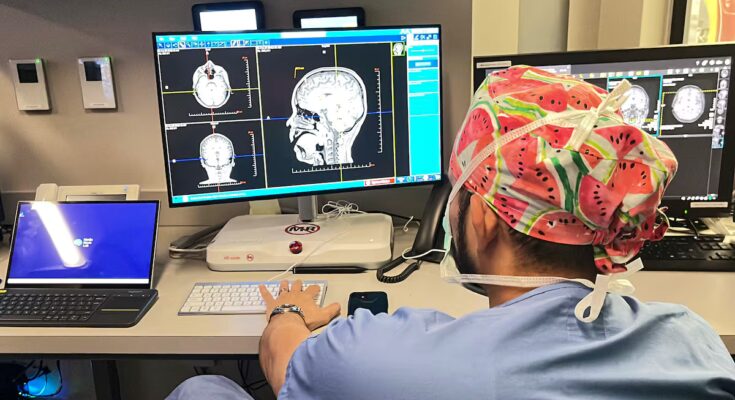There is a controversial medical procedure that has put Spanish neurologists on alert: it is a minimally invasive surgery, performed by plastic surgeons, that promises to cure migraines. In Spain it is a residual practice, offered only by some private clinics, but neurologists raise the alarm when they notice that these procedures are proliferating: they warn that there is not enough scientific evidence, not even a biological explanation to justify it, and ask patients not to undergo these interventions.
This controversial surgery, widely implemented in the United States, is a minimally invasive surgical procedure that involves decompression of extracranial nerves: surgeons identify areas of pain – trigger points – and there release the nerves they consider compressed. American plastic surgeons defend the effectiveness of this approach, but Spanish neurologists warn that the studies supporting this technique are of low quality, with few patients, very heterogeneous diagnoses (not everyone suffers from migraines) and also diversified surgical procedures.
Its defenders, especially in the field of plastic surgery, assure that, in selected patients, this strategy can work to reduce symptoms and claim to have carried out studies to prove it. However, in Spain, supporters of this technique are few and only. The other medical specialty close to migraine, anesthesiologists, who are usually responsible for pain units, also do not recommend it. Migraine is a disease that affects 12% of the population, although neurologists estimate that over 40% go undiagnosed and do not access adequate treatment.
Controversial migraine surgery has its origins in serendipity, in a chance discovery by surgeon Bahman Guyuron earlier this century, when some of the patients on whom he performed a forehead lift told him that, after the plastic surgery, they stopped suffering from migraines. From there, Guyuron theorized that migraines occur when the peripheral branches of the trigeminal nerve become irritated and release neurotoxins, and he adapted the forehead lift to nerve decompression surgery.
Without biological justification
“It is scandalous that this technique is allowed without evidence,” protests Robert Belvís, coordinator of the Headache Study Group of the Spanish Society of Neurology (SEN). The doctor claims that migraine surgery “has no biological plausibility”, that is, there is no pathophysiological explanation that justifies this intervention: “Migraine is a brain disease, it makes no sense to decompress the nerves. It has not been seen that there are altered nerves. They have not proven that these compressions exist.”
The neurologist also points out that the international guidelines on the treatment of migraine, which contain the scientific consensus to address this condition, do not even mention these surgical techniques.
The American Society of Plastic Surgeons, however, considers it in its clinical practice. And it assures that candidates are people diagnosed with migraine or occipital neuralgia, who have tried other therapeutic approaches without success, who enjoy good physical health and “have realistic expectations”. According to this scientific society, the price of these interventions varies between 5,000 and 15,000 dollars. And the effectiveness, declared on its website, is high: “Between 70% and 95% of patients who undergo surgery experience improvement or complete elimination of migraines,” he says.
To express its opinion, the Spanish Society of Plastic, Reconstructive and Aesthetic Surgery refers to Ahmad Saad, American plastic surgeon and member of the board of directors of the International Society of Plastic Surgery. The doctor, who also practices in a clinic in Barcelona, is an expert in migraine surgery and defends its validity: “It is not a treatment for everyone, you have to choose the right patient. The trials are of good quality and the experience with thousands of patients is there.”
When questioned about the neurologists’ position, Saad underlines: “The evidence is there, but I don’t know if they don’t want to see it or don’t want to accept it. When the fathers of this technique started doing it in the United States, they waged a war with the neurologists, but today it is the standard of care. In Spain it’s not like that: you have the world of neurology against you.” Regarding the limited application of this technique in Spain, the American doctor assures that “it is not that there are no surgeons to do it, the problem is that there are no patients”: “Patients with migraine are referred to neurologists. If these doctors do not believe in migraine surgery, you will not have patients.”
Belvís claims that this technique has not gone through the animal testing phase and questions the research channels followed before transferring it into conventional clinical practice.
Questionable scientific evidence
As for the available scientific evidence, Saad shares around thirty studies, most of them conducted by Guyuron and his team, that indicate the feasibility of these techniques, including some clinical trials. But Belvís takes note: “It’s not a question of quantity, but of quality,” he says, and recalls that the available studies are conducted with few patients and with different surgical approaches. Usually there aren’t even neurologists among the researchers who sign the studies and they usually get published, especially in plastic surgery journals, he wonders. “To be placed on the market, all drugs require three studies with more than 1,200 patients. The people recruited in the three studies with this intervention do not reach 200.”
A review of 600 treated patients published in Frontiers in Neurology they reduced the effectiveness and concluded that this intervention manages to eliminate migraines in 38% of patients with this diagnosis included in their analysis. But he stressed: “More comprehensive randomized trials with transparent reporting on patient selection, drug use and surgical procedures, and with the implementation of longer and more detailed follow-up periods are needed.”
Agustín Mendiola de la Osa, vice president of the Acute and Chronic Pain section of the Spanish Society of Anesthesiology, Resuscitation and Pain Therapy (SEDAR), underlines along the same lines as Belvís: “With migraine surgery we don’t have good results. What we have seen in some treated patients is that, at the beginning, they seem to be fine, but then not. It seems more that I want and can’t, that they want to get better, but reality falls of its own weight. For the “Non we recommend surgery for migraines because there is no medical explanation that justifies it.”
“Legally questionable”
In its statement, the SEN assures that the objective of its appeal is not only to address patients and doctors, but also the directors of Spanish clinics, public and private, “which allow surgical interventions without scientific evidence to be performed as conventional care services”, they protest. “We believe that, moreover, it is also legally questionable,” they say, although they have not filed any official complaint with health authorities.
When asked by this newspaper, the Ministry of Health assures that it has not received any formal complaint in this regard, but a spokesperson underlines: “Health centers (public or private) have the responsibility to ensure that the procedures they offer are safe, ethical and based on scientific evidence, and must have regional health authorization. If they offer techniques without scientific support, they may incur administrative or professional liability.” Likewise, we remind you that “any new technique, procedure or health technology can be subjected to evaluation by the Spanish Network of Health Technology Assessment Agencies (RedETS)”, a body coordinated by Health. Their reports serve as a basis, for example, for including or excluding a technique within the National Health System. But no organization has asked RedETS to evaluate migraine surgery in particular.



